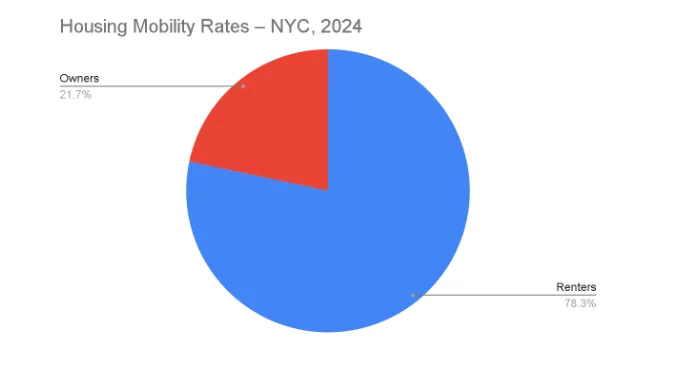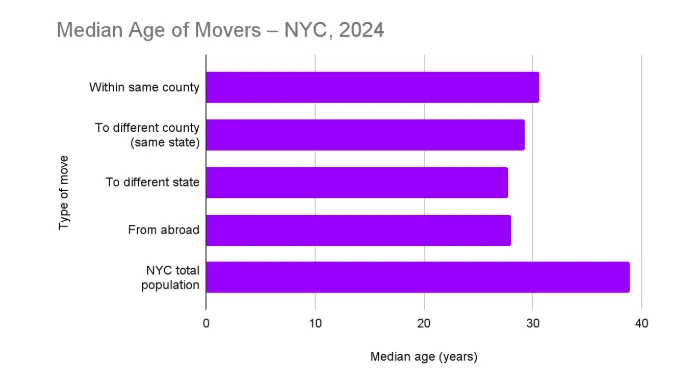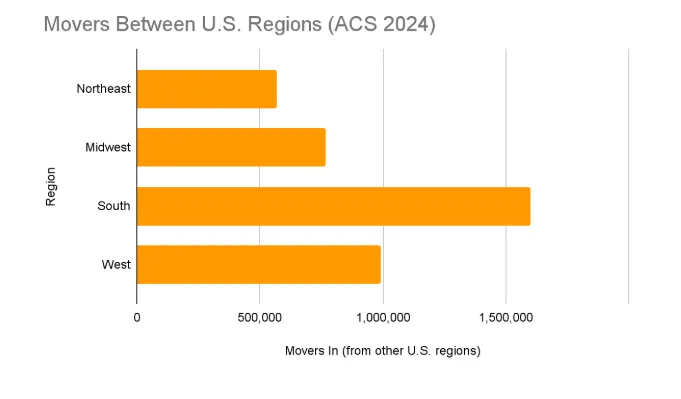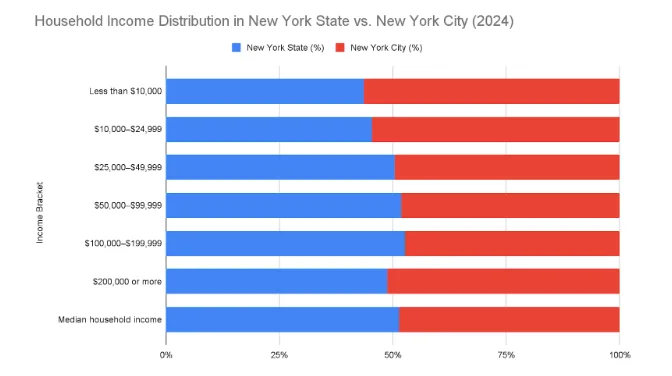Millions stay, but the young are leaving – Is New York losing its future?
Change is the only constant, they say. And in our youth that feels truer than ever. We chase stability and freedom at the same time, always curious about what comes next. But in New York, that restless energy is showing up somewhere else: in the moving data.
Fresh data from the U.S. Census Bureau’s American Community Survey (ACS) 2024 reveals a striking pattern: New York City’s movers are overwhelmingly young. Approximately 50 percent of NYC movers are 18 to 34 years old. Millennials and Gen Z together account for about half of all moves in the city [1].
While this youthful dynamism might sound promising, it also raises questions about housing, affordability, and the city’s long-term sustainability.
The numbers behind the shift
The data from the ACS 2024 shows that young adults are much more mobile than older generations in New York City. The highest mobility rates are found among those under 35, with Millennials and Gen Z making up a disproportionately large share of movers.
While nearly 1 in 12 New Yorkers aged 25–34 relocated in the past year, mobility drops sharply with age. This imbalance means that the city’s housing market, workforce, and tax base are increasingly shaped by the decisions of its youngest residents.

Why young movers matter
New York’s economy thrives on a steady influx of young, educated workers. However, when high mobility translates into out-migration rather than moves within the city, New York risks losing the demographic that drives its innovation, workforce renewal, and tax base [1].
One of the clearest signs of this challenge comes from housing. The data shows a clear divide between renters and homeowners. Renters are about 2 to 3 times more likely to move than owners. In New York City the ratio is roughly 2.1x, and statewide it is about 2.7x. This gap helps explain why younger renter households experience the greatest instability.
For many young New Yorkers, every lease renewal becomes a high-stakes decision: absorb rising rents or leave in search of affordability.

The youth-driven migration pattern
The median age for within-county movers in New York City is 31.2 years. Movers coming from outside the county are even younger on average, so the overall mover median sits in the low 30s [2]. Mobility skews heavily toward the young:

Behind New York’s migration trends are the choices of young people searching for balance, affordability, and belonging. If this outflow continues, the city could face not just an aging population, but a quieter, slower rhythm of life.
Demographic contrast: New York City vs. New York State
An additional comparison with statewide demographics underlines this imbalance. New York State is older on average than New York City. In 2024 the city’s median age was lower than the state’s, and the share of residents in young adult brackets was higher in the city [3]. This reinforces the fact that the city’s demographic renewal depends almost entirely on its youngest generations.
| Category | New York State | New York City |
| Median Age | 40.4 | 38.9 |
| Population 18–34 | ~22% | ~25% |
| Population 65+ | ~16% | ~14% |
Regional competition and the pull of the South
Nationwide in 2024, the South recorded the largest net inflows of movers, while the Northeast posted net outflows [4].
By contrast, the Northeast lost more than one million residents to other regions, underlining its persistent struggle with affordability and out-migration. The Midwest and West, while still experiencing significant mobility, showed relatively balanced flows of arrivals and departures.
For younger professionals, this shift is especially telling. Southern and Midwestern cities often combine lower living costs with expanding economic opportunities, making them appear far more sustainable than New York City for those trying to build both a career and a stable future.

Why don’t paychecks go far enough in NYC
New York may offer opportunity, but the numbers tell a different story when it comes to affordability. The median household income in New York City was $81,228 in 2024, with wide dispersion across income brackets [5].
The problem is not only low medians but sharp inequality. Nearly 1 in 8 households survives on under $10,000 a year, while only a small minority crosses the $200,000 mark. For Millennials and Gen Z renters, this reality makes staying in New York increasingly untenable. Every lease renewal feels like a choice between sinking deeper into financial strain or starting fresh somewhere their paycheck actually lasts.

The remote work factor
The expansion of remote work has fundamentally altered the way younger generations think about relocation. For Millennials and Gen Z, mobility is no longer tied strictly to the availability of jobs in a given city. Instead, the decision to move is increasingly driven by affordability, lifestyle, and flexibility [6].
Cities across the South and Midwest, where housing is more affordable and professional opportunities are growing, have become far more appealing alternatives to New York. If New York does not adapt, by providing not just jobs but livable, affordable communities, it risks falling behind in the fight for talent.
What this means for the future
The broader picture is both clear and sobering. New York relies heavily on Millennials and Gen Z to sustain its growth, yet these are the very groups most likely to leave. Without meaningful action to address affordability, housing pressures, and quality of life, the city’s competitive advantage could slip further.
At the same time, youth mobility is not only a risk but also a source of renewal. Each new wave of movers contributes diversity, innovation, and cultural vibrancy to the city. The challenge lies in ensuring that these generations see New York not merely as a temporary stop but as a long-term home.
Keeping New York in motion
With about half of all movers under the age of 35, the future of New York is inseparable from the choices of its youngest generations.
Whether this mobility drives renewal or decline will depend on how effectively the city responds to mounting pressures in housing and affordability. The strong and growing demand for NYC movers highlights just how dynamic and competitive, the relocation landscape has become.
Sources
- U.S. Census Bureau. Geographic Mobility by Selected Characteristics in the United States. ACS 1-Year Estimates, Table S0701 (2024).
- U.S. Census Bureau. Geographic Mobility by Selected Characteristics in New York City. ACS 1-Year Estimates, Table S0701 (2024).
- U.S. Census Bureau. Age and Sex. ACS 1-Year Estimates, Table S0101 (2024).
- U.S. Census Bureau. Median Age by Geographical Mobility in the Past Year for Current Residence in the United States. ACS 1-Year Estimates, Table B07002 (2024).
- U.S. Census Bureau. Movers Between Regions. ACS 1-Year Estimates, Table S0702 (2024).
- U.S. Census Bureau. Income in the Past 12 Months (in 2024 Inflation-Adjusted Dollars). ACS 1-Year Estimates, Table S1901 (2024).
